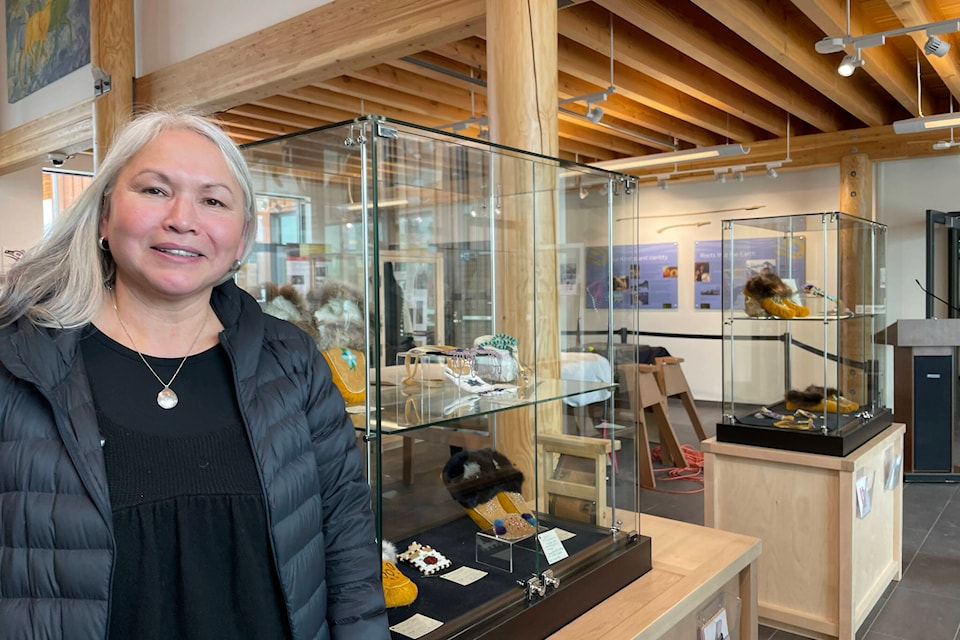A new First Nations art exhibit opened at Haa Shagóon Hídi in Carcross on March 21.
Advertised with a strong salmon motiff, “Returning” is one in a series of exhibits around the territory presenting work of students attending the Yukon First Nations Art certificate program taught out of Yukon University’s community campuses.
It was not planned this way. When the program started in 2019, it was to be delivered in Whitehorse only.
After the first module of the program was conducted in March 2020, COVID-19 struck and the program was abruptly shut down.
But by fall, a new vision had been worked out to deliver the program in 12 different communities — six communities in one year, and another six in year two.
“It was such a blessing in disguise,” explained Elizabeth Bosely, instructor-coordinator for the university’s art certificate programs.

Yukon University’s First Nation art certificate program is based on the traditional arts program out of the Northwest Territories, and the native cultural arts program out of Portage College in Lac La Biche, Alberta. It combines basic math and English courses with Indigenous art practices and includes two business modules to learn the business of making art and making a living.
The entire set of 12 modules takes a full semester and students who complete the program are awarded a certificate.
The six art modules are traditional beadwork, sewing, traditional footwear, drawing and carving, and fine craft work and product development. Attention is paid to market readiness and the detailing needed for fine craft finishing.
Bosely easily found local artisans from each community to serve as instructors for the program. Last year, the program was conducted in McIntyre for Kwanlin Dün, Teslin, Old Crow, Mayo, Pelly and Carmacks.
This years’ offerings were in Dawson, Carcross, Haines Junction and Ross River. “We offered another one in Pelly and we did one for Ta’an and Kwanlin Dun in the fall and then we partnered with them again.”

In Carcross, the lead instructor was Joyce Hall for the beadwork, sewing and traditional footwear component. Other local artisians who taught and worked with the students were Shirley Lord and Violet Gatensby. Diane Olsen drove out from Whitehorse to teach two of the modules as well.
The students learned applique, embroidery, quillwork, fish scale art, tufting and several different stitch techniques. Even the most experienced students learned something new. New approaches were experimented with, like Leslie Cawley’s hot pink mukluks and 3-dimensional beading technique.
The programming was significant for communities, Bosely explained.
As COVID-19 closed people off from their connections and as people grieved losses in their communities – there was the art, the program and fellow students.
“I’ve heard that time and time again from all of the communities, how grateful the students were, that they were able to put all their troubles away, because for anybody who engages in art, and when you’re doing art, you have to be totally focused in the moment,” Bosely said. “It has been such a saving grace.”
Bosely explained that making craft can be a therapeutic way to just “let go of all the problems of the world and sink into your art— just give it your heart, your attention, and create something really beautiful.”
And even though the pandemic reduced some venues for the sale of art, Bosley says that the Indigenous fine arts are flourishing as a cultural industry. “It did not die down even though we were in the middle of a pandemic. Earrings, for example, were a pretty hot commodity during the pandemic and a lot of people were making them and a lot of people were buying them.”

Students were taught to take advantage of a rising market for Indigenous crafts in the program’s two business classes.
Managing Your Art Career was developed and delivered by people from Dana Naye Ventures. The business modules looked beyond the standard business concepts of inventory, pricing, and income statements, and also included the expectations of artists in the art world in terms of artist statements, bios and CVs.
Ross River students just displayed their work at the campus there, and Dawson’s student work is on its way to Whitehorse to join with an exhibition at the Kwanlin Dün Cultural Centre with the Whitehorse students from April 15 to May 1.
Gisela Niedermeyer, the instructor-coordinator at the Carcross campus said that the students could have displayed in Whitehorse, but chose to display their work in their home community. Carcross artists Alvin Jim, Cynthia Beattie, Dawn Sembsmoen, Donna Johns, Leslie Cawley, Sahara James, Steve Glada and Tara Grant participated in the program.
Niedermeyer explained how the students selected the symbol of the salmon, swimming against the current so that it could return to its roots and give life for the future, as the central motiff for the exhibition.
Returning: Haa léelkʼu hás ḵunóogu sh tóo tultóow [Learning our Ancestors Ways] will be on display until May 19 at Haa Shagóon Hídi.
Contact Lawrie Crawford at lawrie.crawford@yukon-news.com
